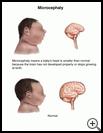
Microcephaly
________________________________________________________________________
KEY POINTS
- Microcephaly is a birth defect that causes a baby’s head to be smaller than normal because the brain has not developed properly or stops growing after birth.
- Treatment depends on how severe your child’s symptoms are.
- Work with your child’s treatment team to learn how best to help your child, including ways to respond to behavior problems.
________________________________________________________________________
What is microcephaly?
Microcephaly is a birth defect that causes a baby’s head to be smaller than normal because the brain has not developed properly or stops growing after birth.
Children with microcephaly may reach goals and milestones more slowly, but most can go to school, get jobs, and enjoy many of the same kinds of things that other kids do.
What is the cause?
Microcephaly may be inherited, which means that it is passed from parents to children through their genes. Genes are inside each cell of the body. They contain the information that tells the body how to develop and work. Babies may have microcephaly alone or they may have microcephaly along with other birth defects.
Microcephaly may be caused during pregnancy if the mother:
- Uses drugs or drinks alcohol
- Is infected with rubella, cytomegalovirus, Zika virus, toxoplasmosis, or other viruses
- Is exposed to toxic chemicals such as lead, mercury, and some chemical fertilizers
- Has a poor access to food and does not get needed nutrients and vitamins
- Has a problem with the blood supply to the baby’s brain during growth in the womb
- Has untreated phenylketonuria, which means the body is not able to break down an amino acid called phenylalanine
What are the symptoms?
The baby’s symptoms may be mild or severe and may include:
- Seizures
- Slower learning to walk, feed self, or talk
- Intellectual disability, which is a decreased ability to read, write, understand, solve problems, or take care of self
- Trouble controlling legs and arms, which may affect movement and balance
- Trouble swallowing and poor feeding
- Hearing loss
- Vision problems
How is it diagnosed?
Microcephaly may be diagnosed before birth, or shortly after birth during a baby's first physical exam.
The diagnosis before birth may be based on:
- Blood tests of the mother
- An ultrasound, which uses sound waves to show pictures of the unborn baby
The diagnosis after birth is usually based on measuring the size of the baby’s head. Other tests may include:
- MRI, which uses a strong magnetic field and radio waves to show detailed pictures of the head and brain
- CT scan, which uses X-rays and a computer to show detailed pictures of the head and brain
What is the treatment?
There is no treatment that will correct the size or shape of the baby’s head. Treatment depends on how severe your child’s symptoms are. Before you decide on your child's treatment, find out what your options are. Learn as much as you can and make your choice for your child's treatment based on your child's needs.
Babies with microcephaly may be able to get special help in the first years of life if they need the services available. This is called early intervention and may include speech, physical and occupational therapies.
Children with severe symptoms may need more support from school psychologists, social workers, school nurses, or aides. A cognitive behavioral therapist can help your child learn to manage stress. Treatment will also include doing certain activities at home.
How can I help my child?
- Look for your child’s strengths. No one knows what your child may be able to do in time, so don’t set your expectations too low. Encourage your child to try new things.
- Work with your child’s treatment team to learn how best to help your child, including ways to respond to behavior problems.
- Join a support group. Support groups can help by sharing common concerns and solutions to problems with other families in the same situation. You can find these services through your healthcare provider, schools, therapy programs, and local and national support organizations.
- Pay attention to your own physical, mental, and emotional health. When you take care of yourself, it helps you and your loved one. You may want to see a mental health professional to help you cope with your stress.
Last modified: 2022-01-03
Last reviewed: 2020-01-09

